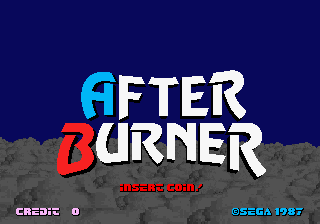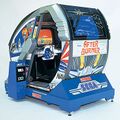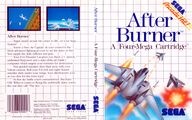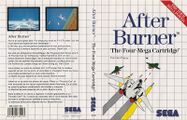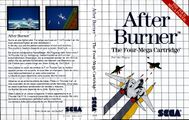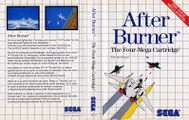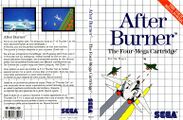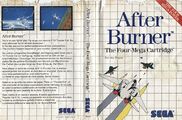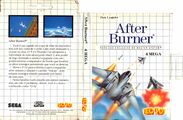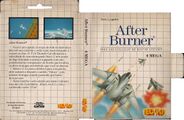Difference between revisions of "After Burner"
From Sega Retro
m (Text replacement - " {{ref|" to "{{ref|") |
|||
| Line 8: | Line 8: | ||
| genre=Shoot-'em-Up | | genre=Shoot-'em-Up | ||
| releases={{releases | | releases={{releases | ||
| − | | arcade_date_jp=1987-07-17 {{ref|http://sega.jp/fb/segahard/master/gallery.html}} | + | | arcade_date_jp=1987-07-17{{ref|http://sega.jp/fb/segahard/master/gallery.html}} |
| arcade_date_eu=1987-10 {{fileref|CVG UK 073.pdf|page=134}} | | arcade_date_eu=1987-10 {{fileref|CVG UK 073.pdf|page=134}} | ||
| arcade_date_world=1987 | | arcade_date_world=1987 | ||
| Line 36: | Line 36: | ||
''After Burner'' stands as one of [[Sega]]'s most successful arcade games, building on the momentum started earlier in the decade with ''[[Hang-On]]'', ''[[Space Harrier]]'' and ''[[OutRun]]''. It was the first game to utilise [[Sega X Board]] technology, allowing for the easy scaling and rotation of in-game sprites, producing three-dimensional graphics. It is also remembered for its then-revolutionary sit-down cabinet design, complete with a horizontally rotating seat and a vertically rotating cockpit, controlled (like the game) by the integrated analog flight stick, with the cabinet's motion corresponding to the joystick's movement. | ''After Burner'' stands as one of [[Sega]]'s most successful arcade games, building on the momentum started earlier in the decade with ''[[Hang-On]]'', ''[[Space Harrier]]'' and ''[[OutRun]]''. It was the first game to utilise [[Sega X Board]] technology, allowing for the easy scaling and rotation of in-game sprites, producing three-dimensional graphics. It is also remembered for its then-revolutionary sit-down cabinet design, complete with a horizontally rotating seat and a vertically rotating cockpit, controlled (like the game) by the integrated analog flight stick, with the cabinet's motion corresponding to the joystick's movement. | ||
| − | Its analog flight-stick controls moved in all directions and measured the degree of push, a precursor to the analog thumbsticks of the N64 and later consoles. ''After Burner''<nowiki>'</nowiki>s gameplay also featured a lock-on system, which was adopted by later rail shooters such as Sega's ''[[Panzer Dragoon (series)|Panzer Dragoon]]'' and ''[[Rez]]'' {{ref|''Retro Gamer'', {{num|145|page=28}}}}. | + | Its analog flight-stick controls moved in all directions and measured the degree of push, a precursor to the analog thumbsticks of the N64 and later consoles. ''After Burner''<nowiki>'</nowiki>s gameplay also featured a lock-on system, which was adopted by later rail shooters such as Sega's ''[[Panzer Dragoon (series)|Panzer Dragoon]]'' and ''[[Rez]]''{{ref|''Retro Gamer'', {{num|145|page=28}}}}. |
==Gameplay== | ==Gameplay== | ||
| Line 45: | Line 45: | ||
==History== | ==History== | ||
===Development=== | ===Development=== | ||
| − | ''After Burner'' was inspired by [[Yu Suzuki]]'s real-life experience of personally piloting a real jet aircraft and participating in air combat when he visited Florida, United States: {{ref|1=[http://www.shenmuedojo.net/forum/viewtopic.php?t=46577 Yu Suzuki Interview], ''[[wikipedia:Strana Igr|Strana Igr]]'', November 2013}} | + | ''After Burner'' was inspired by [[Yu Suzuki]]'s real-life experience of personally piloting a real jet aircraft and participating in air combat when he visited Florida, United States:{{ref|1=[http://www.shenmuedojo.net/forum/viewtopic.php?t=46577 Yu Suzuki Interview], ''[[wikipedia:Strana Igr|Strana Igr]]'', November 2013}} |
{{quote | At first, after reading all the appropriate guides, they lectured us for a couple of hours, explaining everything. Afterwards, I got into a jet aircraft, and flew around with an instructor. The aircraft was equipped with a laser gun and smoke bombs. And there were two of us. If you hit the opponent, a smoke bomb activates, and that means he was shot. And we were flying around for about two hours shooting each other. }} | {{quote | At first, after reading all the appropriate guides, they lectured us for a couple of hours, explaining everything. Afterwards, I got into a jet aircraft, and flew around with an instructor. The aircraft was equipped with a laser gun and smoke bombs. And there were two of us. If you hit the opponent, a smoke bomb activates, and that means he was shot. And we were flying around for about two hours shooting each other. }} | ||
Revision as of 17:19, 7 September 2016
| After Burner | |||||||||||||||||||||||||||||||||||||||||||||
|---|---|---|---|---|---|---|---|---|---|---|---|---|---|---|---|---|---|---|---|---|---|---|---|---|---|---|---|---|---|---|---|---|---|---|---|---|---|---|---|---|---|---|---|---|---|
| System(s): Sega X Board, Sega Master System | |||||||||||||||||||||||||||||||||||||||||||||
| Publisher: Sega | |||||||||||||||||||||||||||||||||||||||||||||
| Developer: Sega AM2 | |||||||||||||||||||||||||||||||||||||||||||||
| Genre: Shoot-'em-Up | |||||||||||||||||||||||||||||||||||||||||||||
|
- For the Western home computer versions, see After Burner (home computers).
After Burner (アフターバーナー) is a third-person rail shooter arcade game designed by Yu Suzuki and developed by Sega AM2 in 1987. The game was released in three variations: a standard upright cabinet, and two cockpit versions, one that tilts left and right, and one a rotating cockpit version. An updated version was released months later, After Burner II.
After Burner stands as one of Sega's most successful arcade games, building on the momentum started earlier in the decade with Hang-On, Space Harrier and OutRun. It was the first game to utilise Sega X Board technology, allowing for the easy scaling and rotation of in-game sprites, producing three-dimensional graphics. It is also remembered for its then-revolutionary sit-down cabinet design, complete with a horizontally rotating seat and a vertically rotating cockpit, controlled (like the game) by the integrated analog flight stick, with the cabinet's motion corresponding to the joystick's movement.
Its analog flight-stick controls moved in all directions and measured the degree of push, a precursor to the analog thumbsticks of the N64 and later consoles. After Burner's gameplay also featured a lock-on system, which was adopted by later rail shooters such as Sega's Panzer Dragoon and Rez[5].
Contents
Gameplay
In After Burner, the player pilots an F-14 Tomcat-inspired jet through 18 levels, destroying enemies with machine gun fire and a limited supply of missiles. Similar to Space Harrier, it is an "on-the-rails" shooter - the plane will travel continuously into the screen, with players only able to adjust its X and Y coordinates.
The objective in After Burner is to survive through each of the 18 stages, usually by avoiding enemy missile fire, however "bonus" stages, which occur every six levels, require the player to dodge scenery and not crash. Shooting down enemies is technically optional, although alleviates the risk of being destroyed. The player has a limited supply of missiles which are refueled at various intervals throughout the game.
History
Development
After Burner was inspired by Yu Suzuki's real-life experience of personally piloting a real jet aircraft and participating in air combat when he visited Florida, United States:[6]
| “ | At first, after reading all the appropriate guides, they lectured us for a couple of hours, explaining everything. Afterwards, I got into a jet aircraft, and flew around with an instructor. The aircraft was equipped with a laser gun and smoke bombs. And there were two of us. If you hit the opponent, a smoke bomb activates, and that means he was shot. And we were flying around for about two hours shooting each other. | „ |
| “ | After that, I realized that all games about aircraft aren't interesting enough. ... Because in those it was much more difficult to control the aircraft than in real life. Seriously! And I realized something: all those flight simulators were created by people who hadn't even flown a real aircraft! | „ |
After Burner was originally designed to have melodies play over the "After Burner/Red Out" and "Final Take Off" music tracks, but these were taken out of the final game, potentially through fears that they'd be drowned out in a busy arcade environment. Though these versions were never heard in the arcades, they adapted for the album Sega Game Music Vol. 3 After Burner in 1987 (appearing in other albums since), and have been brought back as options in later games (for example, 3D After Burner II). The melodies were also used for the FM Towns version released in 1989, in a remixed CD format.
Legacy
The original After Burner was released exclusively in Japan, however the western world would receive an updated version of the game, After Burner II in the months which followed. After Burner II is extremely similar in design, bar a few minor tweaks (such as a throttle control, extra levels and slight changes to the missile system), so much so that people often consider it to be a more "complete" version of After Burner than a direct sequel. Due to the similarities and shared cabinet designs and artwork, After Burner II is frequently confused for the original After Burner. A similar relationship would develop with Galaxy Force and Galaxy Force II, also produced by Sega AM2.
In its original form, After Burner was only ported to the Sega Master System, however many ports of After Burner II were released under the name of After Burner for home consoles and computers, including the Amiga (twice), Amstrad CPC, Atari ST, Commodore 64, DOS, FM Towns, MSX, PC Engine, Sharp X68000 and ZX Spectrum.
It was also ported to the Sega 32X by Rutubo Games and went under the name of After Burner Complete.
After Burner in its original form was also released as part of Sega Arcade Gallery for the Game Boy Advance.
Critical reception
- See Physical scans section for review scores
In Japan, the arcade game was well received. The 1987 Gamest Awards gave it the award for "Best Graphics". It was also the runner-up for Gamest's "Game of the Year" award, and also came eighth place for the "Best Speech Synthesis" award and sixth place for the "Best Ending" award.[7]
In Europe, the arcade game was also well received. Clare Edgeley gave it a positive review in the November 1987 issue of Computer and Video Games magazine, where she recommended the audience to try it out.[8] In the 1987 Christmas Special issue of Crash, Julian Rignall and Daniel Gilbert gave it a more mixed review. They stated, "Sega, maker of Super Hang-On and Out Run, has just released its most impressive-looking game" yet, "an aerial-combat simulation" with "colourful and incredibly fast graphics" that is "possibly the fastest 3-D yet" seen. They also praised the rotating cockpit cabinet which "rocks and rolls as the plane banks and moves" as "very impressive" but criticized the playability, specifically the plane handling and joystick feedback, and the "overpriced" cost of 50p per go (equivalent to £1.23 or $1.94 in 2014).[9] In the February 1988 issue of The Games Machine, Robin Hogg and Cameron Pound gave it a positive review, describing it as the "hottest Sega release so far".[10]
In North America, the August 1988 issue of Computer Gaming World praised After Burner on the Sega Master System.[11]
Production credits
X Board version
The arcade version of After Burner II has no detailed credits screen, instead aliases of the developers are seen on the backs of clothing in the ending sequence:
Gallery
Magazine articles
- Main article: After Burner/Magazine articles.
Promotional material
Master System JP television advert
Master System US television advert
Physical scans
X Board version
| Sega Retro Average | ||||
|---|---|---|---|---|
|
| N/A | |
|---|---|
| Based on 0 reviews | |
| X Board, JP | ||||
|---|---|---|---|---|
Master System version
| Sega Retro Average | |||||||||||||||||||||||||||||||||||||||||||||||||||||||||||||||||||||||||||||||||||||||||||||||||||||||||||||
|---|---|---|---|---|---|---|---|---|---|---|---|---|---|---|---|---|---|---|---|---|---|---|---|---|---|---|---|---|---|---|---|---|---|---|---|---|---|---|---|---|---|---|---|---|---|---|---|---|---|---|---|---|---|---|---|---|---|---|---|---|---|---|---|---|---|---|---|---|---|---|---|---|---|---|---|---|---|---|---|---|---|---|---|---|---|---|---|---|---|---|---|---|---|---|---|---|---|---|---|---|---|---|---|---|---|---|---|---|---|
|
| 64 | |
|---|---|
| Based on 21 reviews | |
| Master System, KR |
|---|
|
Mega-Tech version
References
- ↑ File:CVG UK 077.pdf, page 10
- ↑ 2.0 2.1 2.2 File:ACE UK 07.pdf, page 51 Cite error: Invalid
<ref>tag; name ":File:ACE UK 07.pdf_p51" defined multiple times with different content - ↑ 3.0 3.1 3.2 File:Generation4 FR 004.pdf, page 20 Cite error: Invalid
<ref>tag; name ":File:Generation4 FR 004.pdf_p20" defined multiple times with different content - ↑ http://www.mamedb.com/game/aburner
- ↑ [Retro Gamer, №145, p28 Retro Gamer, №145, p28]
- ↑ Yu Suzuki Interview, Strana Igr, November 2013
- ↑ [Gamest, The Best Game 2: Gamest Mook Vol. 112, p. 6-26 Gamest, The Best Game 2: Gamest Mook Vol. 112, p. 6-26]
- ↑ File:CVG UK 073.pdf, page 134
- ↑ http://www.solvalou.com/subpage/arcade_reviews/76/10/after_burner_review.html
- ↑ File:TGM UK 03.pdf, page 71
- ↑ File:CGW US 050.pdf, page 47
- ↑ File:PowerPlay DE 002.pdf, page 104
- ↑ File:SinclairUser UK 073.pdf, page 82
- ↑ 14.0 14.1 File:ASM DE 1988-03.pdf, page 41 Cite error: Invalid
<ref>tag; name ":File:ASM DE 1988-03.pdf_p41" defined multiple times with different content - ↑ 15.0 15.1 File:CGtC UK 04.pdf, page 89 Cite error: Invalid
<ref>tag; name ":File:CGtC UK 04.pdf_p89" defined multiple times with different content - ↑ 16.0 16.1 File:CVG UK 077.pdf, page 122 Cite error: Invalid
<ref>tag; name ":File:CVG UK 077.pdf_p122" defined multiple times with different content - ↑ 17.0 17.1 File:TGM UK 04.pdf, page 54 Cite error: Invalid
<ref>tag; name ":File:TGM UK 04.pdf_p54" defined multiple times with different content - ↑ 18.0 18.1 File:GamesPreview DK 08.pdf, page 67 Cite error: Invalid
<ref>tag; name ":File:GamesPreview DK 08.pdf_p67" defined multiple times with different content - ↑ 19.0 19.1 File:PowerPlay DE 003.pdf, page 91 Cite error: Invalid
<ref>tag; name ":File:PowerPlay DE 003.pdf_p91" defined multiple times with different content - ↑ 20.0 20.1 File:SegaPro UK 01.pdf, page 18 Cite error: Invalid
<ref>tag; name ":File:SegaPro UK 01.pdf_p18" defined multiple times with different content - ↑ Complete Guide to Consoles, "" (UK; 1989-10-16), page 47
- ↑ The Complete Guide to Sega, "" (UK; 1991-05-xx), page 52
- ↑ Computer Action, "Juli/August 89" (DK; 1989-0x-xx), page 34
- ↑ Console XS, "June/July 1992" (UK; 1992-04-23), page 137
- ↑ Micromanía (segunda época), "Enero 1990" (ES; 19xx-xx-xx), page 27
- ↑ Mean Machines Sega, "October 1992" (UK; 1992-09-xx), page 132
- ↑ Sega News, "Říjen 1996" (CZ; 1996-xx-xx), page 27
- ↑ Sega Power, "October 1991" (UK; 1991-09-05), page 40
- ↑ Sega Power, "October 1991" (UK; 1991-09-05), page 55
- ↑ Sega Pro, "April 1993" (UK; 1993-03-11), page 70
- ↑ Software Gids, "Mei/Juni 1990" (NL; 1990-05-xx), page 31
- ↑ Tilt, "Mai 1988" (FR; 1988-0x-xx), page 100
- Pages with reference errors
- No players field
- JP Master System games
- All JP games
- US Master System games
- All US games
- EU Master System games
- All EU games
- FR Master System games
- All FR games
- UK Master System games
- All UK games
- AU Master System games
- All AU games
- BR Master System games
- All BR games
- KR Master System games
- All KR games
- Master System games
- 1987 Master System games
- All 1987 games
- Master System shoot-'em-up games
- All shoot-'em-up games
- Use romtable template
- All games
- Quote with no reference
- Credits without source
- Credits without reference
- Creditstable with no console field
- GalleryPrintAd file defined
- Old-style rating (pp)
- Use magref
- Old-style rating (cuser)
- External rating reference
- Old-style rating (suser)
- Update ratings template
- 3 old ratings
- No ratings
- Old-style rating (ace)
- Old-style rating (asm)
- Rating without source
- Old-style rating (cgtc)
- Rating without PDF source
- Old-style rating (cvg)
- Old-style rating (gamesmachineuk)
- Old-style rating (gamespreview)
- Old-style rating (gen4)
- Old-style rating (micromania)
- Old-style rating (segapower)
- Old-style rating (segapro)
- Old-style rating (tilt)
- 14 old ratings
- After Burner (franchise)
- X Board games
- Mega-Tech games
